Global Water WQ101 Temperature Sensor
Features
- Sensor output is 4-20mA with a two wire configuration
- Each sensor is mounted on marine-grade cable with up to 500 ft. lengths
- Stainless steel or PVC housing
- Free ground shipping
- Expedited repair and warranty service
- Lifetime technical support
- More
Overview
The Global Water WQ101 is a rugged, reliable temperature measuring device for air or water applications. The probe is mounted on up to 500 ft. of marine grade cable and has a two-wire configuration for minimum current draw. The unit's electronics are completely encapsulated in marine-grade epoxy within a stainless steel housing. The online version comes with ¾ x 6 inch PVC pipe nipple, threaded both ends with cap (¾" NPT PVC housing).
| Output | 4-20 mA |
| Range |
-58 to +122° F (-50 to +50°C) |
| Accuracy | ±0.2°F or ±0.1°C |
| Maximum Pressure | Standard: 200 psi Online: 50 psi |
| Operating Voltage | 10-36 VDC |
|
Current Draw |
Same as sensor output |
| Warm Up Time |
5 seconds minimum |
| Operating Temperature | 58 to +212° F (-50 to +100°C) |
| Size of Probe | Standard: 3/4" Diameter x 4-1/2" L (1.9cm dia. x 11.4cm long) Online: 1-3/4" Diameter x 8" L (4.3cm dia. x 20.3cm long) |
| Weight | Standard: 8 ounces (227g) Online: 9.4 ounces (272g) |
In The News
Monitoring Mariculture in the Gulf of Alaska
The mariculture industry in the Gulf of Alaska has been steadily growing in recent years, guided by ongoing research to help refine farm location and cultivation practices. A subset of aquaculture, mariculture focuses on rearing organisms in the open ocean. In Alaska, finfish farming is illegal, so most farms cultivate kelp, oysters, or a combination of the two. These small, locally operated farms started popping up in the Gulf of Alaska in the early 1990s, when shellfish farming first became legal. Kelp farming did not begin to catch on in the state until 2016. Many of the coastal areas that have grown interested in mariculture are historically commercial fishing communities.
Read MoreSupplying Seattle’s Drinking Water: Using Data Buoys to Monitor the Cedar River Municipal Watershed
Providing clean, safe, and reliable drinking water for the 1.6 million people in the greater Seattle area is a top priority for Seattle Public Utilities (SPU). With limited water supplies, SPU dedicates considerable resources to maintain its watersheds and mountain reservoirs. About 70 percent of Seattle Water comes from the Cedar River Municipal Watershed , and the other 30 percent comes from the South Fork Tolt River Watershed . [caption id="attachment_39574" align="alignnone" width="940"] Data buoy in Chester Morse Lake . (Credit: Kevin Johnson / Seattle Public Utilities) [/caption] Jamie Thompson, a fisheries biologist at SPU, monitors aquatic ecosystems centered on fish listed under the U.S. Endangered Species Act (ESA).
Read MoreData-Driven Advocacy on the Lower Deschutes River
Like many freshwater environments, the Deschutes River in Oregon is under pressure from development, pollution, and climate change. Many rivers, streams and lakes in the Deschutes Basin do not meet Oregon water quality standards –where state water quality monitoring assesses levels of bacteria, pH, dissolved oxygen, temperature, and fine sediment. Hannah Camel is the Water Quality Coordinator for the Deschutes River Alliance (DRA), a non-profit organization that focuses on the health of the lower 100 miles of the Deschutes River–the area most affected by human intervention. As a data-driven organization, the DRA has benefited from the installation of two NexSens X2 data loggers.
Read More


























